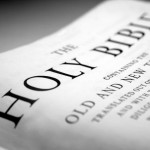Catholics believe that the Bible is the Word of God but what does that mean in today’s world? The Emmaus story gives us some very important pointers about understanding the central role the Bible plays in the life of faith and why it is still at the heart of what we do as believers.
The Scriptures and Jesus
In the Emmaus story the risen Jesus meets his sad and depressed disciples and wants to know why they are so down. They begin to tell him how their hopes had been dashed and why they are going home as deeply disappointed former followers of Jesus. He comes straight back at them by saying that while the events they have described may be true. i.e. the rejection by the authorities of Jesus and his cruel death, how they understand those events is very wide of the mark. In order to do this he goes back over stories from their Bible, (namely the Old Testament). These stories that show how God is faithful, has always wanted to heal, forgive and save his people. They also show that God has been with them even in the worst moments of their long and difficult history. Slowly it begins to dawn on the disciples that there is another way to look at the situation, they begin to make a connection between their lives today and the stories they had been reared with. They now see things in a very different light as the Scriptures become the living Word of God and not just a book about somebody else’s past. Later on they will sum up this experience by saying: “did not our hearts burn within us as he explained the Scriptures to us on the road”.
The Scriptures and the Church
Just as the disciples on the road listened to the Scriptures being explained to them, followers of Jesus have looked to the Scriptures to give them inspiration, hope and guidance ever since. This is why the Church offers us readings every time we gather for the Eucharist. We call this part of the mass the liturgy of the Word and it contains readings from the different parts of the Bible, both Old and New Testaments. The Old Testament is made up of the sacred writings of the Jewish people from before the time of Jesus, and includes the Torah or Law, the writings of the prophets, reflections on their history as well as prayers and wisdom writings. As we saw in the Emmaus story these are the very writings that can help us understand all that happened to Jesus. The New Testament contains writings from the first generations of Christians who reflected on the story of Jesus’ life and the meaning of his death and resurrection. It contains the four Gospels, letters sent to the earliest Christian communities and an overview of the growth and spread of the Church which is called the Acts of the Apostles. Catholics believe that the Scriptures came about through the inspiration of the Holy Spirit and we also believe that the same Spirit that inspired the writing of them should also inspire our reading of them.
The Scriptures and You
Can we have an experience like the disciples on the road to Emmaus and come to an awareness of God’s presence with us today? Yes by praying with the Scriptures and allowing the words speak to our hearts.
For many centuries a method of prayer known as “LectioDivina” has helped ordinary Christians to experience God’s Word in a similar way to the disciples in the Emmaus Story.
Follow these simple steps and watch the two short videos to help further understand Lectio Divina.
Lectio Divina: Using the Bible to help you to pray
Step 1: Ask the Holy Spirit to guide you.
Invite the Holy Spirit to guide you and give you the grace to hear the words of Scripture in all their richness:
God our Father, you sent your only Son, Jesus, into the world.
He revealed you to us.
We ask you to send your Holy Spirit to us now so that we may meet Jesus Christ in the Word that comes from you.
We ask your help in recognising the presence of Jesus in our lives. Amen.
Step 2:
Lectio – Choose a story from the Bible to read.
To begin try Matthew 14:22–33. This is the story of Jesus walking on the water as he approaches his disciples who are in the boat. Begin to read the words very slowly, making sure to give this time with God your full attention. Listen to the words with your whole heart and mind.
Step 3:
Meditatio – Meditate.
Take time to meditate and reflect on the words you have read. Remember that all of the stories and books in the Bible sit together to make a whole. Try to understand the meaning of the words.
Meditate on them for a while and see if you can apply them to your own life. Does the story encourage, or challenge you, is it asking you to look at some part of your life and to make changes?
Listen to what God is saying to you today through these words.
Step 4:
Oratio – Respond to God.
Take time to respond to what you have read. Ask the Holy Spirit to guide you and the risen Jesus to walk with you. What comes into your mind in response to this piece of scripture? Thank God for any insight that has come to you and any awareness of God’s presence with you and ask God’s help with any changes you wish to make in your life.
Step 5:
Promise!
Promise to act on your thoughts and remember your conversation with God today.
Click here for Lesson 4: The Breaking of Bread






